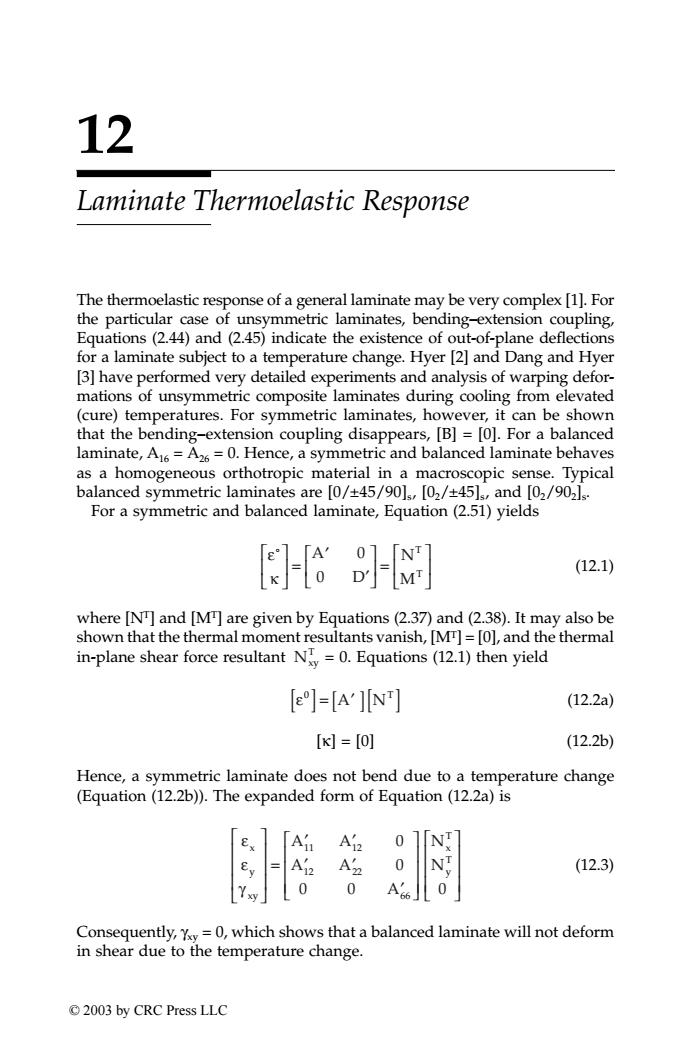正在加载图片...

12 Laminate Thermoelastic Response The thermoelastic response of a general laminate may be very complex [1].For the particular case of unsymmetric laminates,bending-extension coupling, Equations (2.44)and (2.45)indicate the existence of out-of-plane deflections for a laminate subject to a temperature change.Hyer [2]and Dang and Hyer [3]have performed very detailed experiments and analysis of warping defor- mations of unsymmetric composite laminates during cooling from elevated (cure)temperatures.For symmetric laminates,however,it can be shown that the bending-extension coupling disappears,[B]=[0].For a balanced laminate,A=A26=0.Hence,a symmetric and balanced laminate behaves as a homogeneous orthotropic material in a macroscopic sense.Typical balanced symmetric laminates are [0/+45/90],[02/+45]3,and [02/902ls. For a symmetric and balanced laminate,Equation(2.51)yields 日& (12.1) where [NT]and [MT]are given by Equations (2.37)and(2.38).It may also be shown that the thermal moment resultants vanish,[MT]=[0],and the thermal in-plane shear force resultant N=0.Equations(12.1)then yield [e]=[A']N鬥 (12.2a) [K=[O (12.2b) Hence,a symmetric laminate does not bend due to a temperature change (Equation(12.2b)).The expanded form of Equation (12.2a)is N (12.3) 0 Consequently,Ysy=0,which shows that a balanced laminate will not deform in shear due to the temperature change. ©2003 by CRC Press LLC12 Laminate Thermoelastic Response The thermoelastic response of a general laminate may be very complex [1]. For the particular case of unsymmetric laminates, bending–extension coupling, Equations (2.44) and (2.45) indicate the existence of out-of-plane deflections for a laminate subject to a temperature change. Hyer [2] and Dang and Hyer [3] have performed very detailed experiments and analysis of warping deformations of unsymmetric composite laminates during cooling from elevated (cure) temperatures. For symmetric laminates, however, it can be shown that the bending–extension coupling disappears, [B] = [0]. For a balanced laminate, A16 = A26 = 0. Hence, a symmetric and balanced laminate behaves as a homogeneous orthotropic material in a macroscopic sense. Typical balanced symmetric laminates are [0/±45/90]s, [02/±45]s, and [02/902]s. For a symmetric and balanced laminate, Equation (2.51) yields (12.1) where [NT] and [MT] are given by Equations (2.37) and (2.38). It may also be shown that the thermal moment resultants vanish, [MT] = [0], and the thermal in-plane shear force resultant = 0. Equations (12.1) then yield (12.2a) [κ] = [0] (12.2b) Hence, a symmetric laminate does not bend due to a temperature change (Equation (12.2b)). The expanded form of Equation (12.2a) is (12.3) Consequently, γxy = 0, which shows that a balanced laminate will not deform in shear due to the temperature change. ε κ o = ′ ′ = A D N M T T 0 0 Nxy T ε0 [ ] = [ ] A N ′ [ ] T ε ε γ x y xy x T y T A A A A A N N = ′ ′ ′ ′ ′ 11 12 12 22 66 0 0 00 0 TX001_ch12_Frame Page 163 Saturday, September 21, 2002 5:05 AM © 2003 by CRC Press LLC